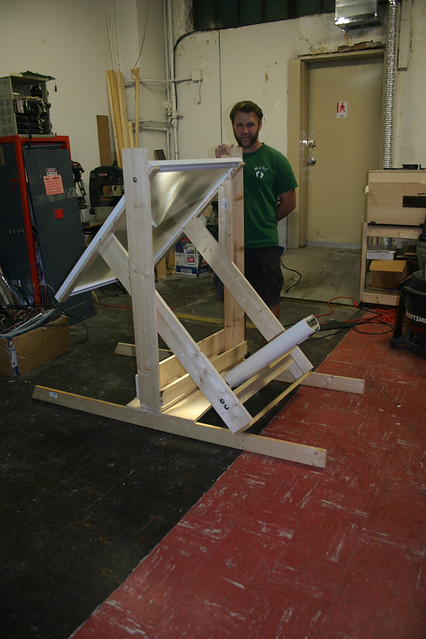Solar Boiler Update
I've gone through quite a few iterations of the solar boiler. The current version uses a 47" Fresnel lens to focus sunlight down to about 1 square inch. The sunlight will focus on an evacuated tube that will transfer the heat into water. The aim is to boil the water and turn a steam engine, ultimately turning a motor and feeding clean energy into the grid. The solar boiler can now pivot in two dimensions allowing it the ability to track the sun as it moves from east to west from the morning until the evening and from north to south as the sun moves between winter and summer. The next step is to build in the tracking system which will consist of two stepper motors that will turn screws pivoting each of the two dimensions to follow the sun. We'll then tie in an MCU attached to some photocells to track the movement of the sun. After the tracker is built the boiler section is next. Honestly, I'm a little nervous about pressurizing steam. That episode of the mythbusters where they blew up the water heater has me a little on edge.



September 26th, 2011 - 01:06
If anyone is interested in helping out on this project. I would LOVE the help. I tend to work in the mornings between 9am-11:30, while my kids are in school.
September 26th, 2011 - 01:07
Oh, also…if anyone knows a thing or two about steam systems, I’d really like to pick your brain.
September 28th, 2011 - 17:29
just keep in mind when steam is in a vessel as the pressure goes up so does the boiling point. when water flashes to steam under pressure it expands several hundred times its volume as a liquid when it cools it “collapses” back to water in effect creating a vacuum. this is what steam venturi vacuum pumps are based on. the thermal shock and the stress on the vessel can be rather violent so i would suggest starting with very small amounts of water and a rather large and substantial vessel in comparison to the volume of water. a pressure relief valve is a must.
September 28th, 2011 - 20:11
Sounds like you know a thing or two! I can produce the heat now, want to help me design the pipes so it doesn’t explode?
September 30th, 2011 - 21:33
How about a stirling engine instead of a boiler? Heat He2 or another stable gas, rather than deal with explosive steam. Heh, the stirling engine was invented specifically because of the explosive tendencies of old coal powered steam boilers.
October 1st, 2011 - 22:48
From what I’ve read, Stirling engines are super efficient. But they require extremely high tolerances which makes them rather difficult to manufacturer. The bigger problem is I can’t find any for sale that are bigger than a toy. Whereas I have found a commercially available steam engine that runs about $4k, that claims 25HP (about 18KW). If I can power that size engine an average of 5 hours a day, it should pay for itself in about a year and half. I’m not against Stirling engines at all, but at this point they don’t seem like a viable option. Another neat engine to look at is the “tesla turbine”. That one actually looks fairly simple to manufacture, but apparently it doesn’t have much torque. I may play with both the stirling and the tesla turbines sometime in the future. For now I want to get this off the ground, so I’m sticking with traditional steam.
October 3rd, 2011 - 00:41
On that episode of Mythbusters they plugged off the pressure relief valve so they would get the dramatic explosion. You, of course, won’t do that!